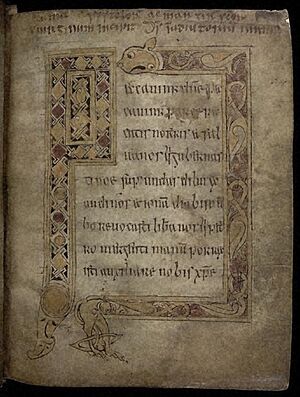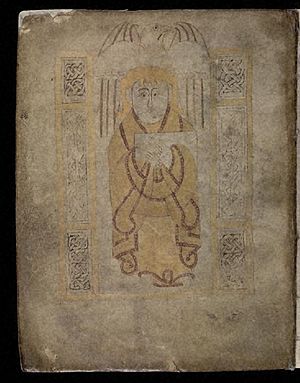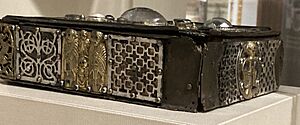Stowe Missal facts for kids
The Stowe Missal is a very old and special Irish book. It's often called a "missal," but it's actually a sacramentary. This means it contains prayers and instructions for church services, especially the Mass. It's also an illuminated manuscript, which means it's a handwritten book with amazing pictures and decorations.
This small book was made in Ireland around the late 700s or early 800s. It's mostly written in Latin, but some parts are in Old Irish. Around the mid-1000s, people at Lorrha Monastery in County Tipperary, Ireland, added notes and rewrote some pages.
What makes the Stowe Missal even more unique is its special protective box. This box, called a cumdach (pronounced "KOOM-dakh"), is like a fancy reliquary or shrine for the book. It was made between 1026 and 1033. The box was decorated many times over the years, especially before 1381.
The book got its name, "Stowe Missal," because it was found in the 1700s as part of the Stowe manuscripts collection in England. In 1883, the collection was bought by the Irish nation. The Missal and other Irish books were given to the Royal Irish Academy in Dublin, where it is still kept today.
The cumdach (book-shrine) was later moved to the National Museum of Ireland. For a long time, people thought the book and its shrine left Ireland around 1375. However, it seems they were hidden inside a stone wall at Lackeen Castle near Lorrha in the 1700s. They were likely hidden there for hundreds of years to protect them from invaders and looters.
Contents
The Ancient Book Itself
The Stowe Missal has 67 pages, called folios. Each page is about 15 centimeters tall and 12 centimeters wide. Most of the book is written in Latin. Only the last three pages are in old Irish. These Irish pages include a short guide about the Mass. The very last page even has three old spells! These spells were meant to protect against eye injuries, thorns, and certain illnesses.
The Latin parts of the book start with sections from the Gospel of John. These first pages are the most decorated. After that, you'll find the order of Mass and some special Masses. There are also instructions for Baptism and for giving Communion to newly baptized people. Finally, there are prayers for visiting the sick and for Last Rites.
Experts believe the original book was written before 800 AD. This is because it includes prayers for a saint named Ruain, who died in 792. His monastery in Tallaght, near today's County Dublin, is probably where the book was first copied.
The way the Mass is described in the book is thought to be even older than the manuscript itself. It shows how church services were done in early Celtic Christianity. The first five scribes (writers) of the Missal used a sharp, angular writing style. Later, a scribe named Moél Caích used a more flowing style. He updated some pages and added a mix of Gallican and Roman church practices.
Even later, before 1033, another scribe added decorations to plain letters. This scribe used a pointed pen to draw heads and other designs. This later decoration helps us date the book. It's believed that Find Ua Dungalaig, who probably ordered the book's shrine, died in 1033.
Amazing Art and Decoration
A few letters in the book are very decorated. For example, on the first page, there's a "crude" but full-page picture of Saint John. He is shown with his symbol, the eagle. This picture is decorated with Insular interlace patterns, which are complex woven designs. The bottom of the page shows a long, stretched-out animal. This eagle picture looks a bit like the one in the Book of Mulling. Its style is similar to the Lindisfarne Gospels from the 700s.
Other decorated letters look like "knotted wire." Some pages even show human faces inside the letters O and D. The face in the letter D looks like the human-like designs found in the famous Book of Kells.
The small size of the Stowe Missal is important. It was made to be a "pocket book." This means a priest could easily carry it with him. He could use it for Mass in different towns, or for baptisms and last rites.
The Cumdach: A Book's Special Shrine
The Stowe Missal still has its original cumdach, or book-shrine. This is a special type of case for books, unique to Ireland. These cases were made for books connected to important religious figures. The Stowe Missal's cumdach is one of only five early examples still existing.
The cumdach is a box made of oak wood. Metal plaques are attached to the wood with nails. The metalwork is very detailed and decorated. It includes some animal and human figures. One side and the edges of the box were likely made between 1026 and 1033. We know this from inscriptions on them that talk about who donated and made the shrine. The other side of the box is newer, from about 1375, also based on its inscriptions. Because of its age, the 11th-century part of the cumdach is one of the oldest known, after the Soiscél Molaisse (made 1001–1011).
The Older Side of the Shrine
The older "lower" side of the cumdach is now separate from the main case. It's made of silver-gilt copper alloy. This means it's copper alloy covered with a thin layer of silver and gold. It has a large cross in the middle, surrounded by a border. The border and the arms of the cross have inscriptions in Irish. The center of the cross was later changed, probably when the newer side was added. A large stone (now missing) was placed there, surrounded by four curved sections.
Because of these changes, some parts of the inscription are missing. But we can mostly figure out what it said. It asks for prayers for Mathgamain Ua Cathail, who was the abbot of Lorrha and died in 1037. It also mentions Find Ua Dúngalaigh, a king who died in 1033. The inscription also names Donnchadh mac Briain, the son of the famous Irish king Brian Boru. He is called "king of Ireland." Another king, Mac Raith Ua Donnchada, is mentioned, along with the name of the maker, Donnchadh Ua Taccáin, a monk. The four spaces between the cross and the border have geometric designs. The corners of the border and the ends of the cross have small knotwork decorations.
The Sides and Newer Side
The sides of the cumdach have copper alloy plaques that are not silvered. These plaques show figures of angels, animals, priests, and warriors. They are set against decorated backgrounds.
The newer "upper" side of the cumdach is made of silver-gilt. It also has a cross in the center. This cross has a large oval rock crystal stone in the middle, surrounded by curved sections and other gems. The inscription on this side is engraved on plain silver plaques. It runs around the border and in the spaces between the cross and the border. These spaces have four engraved figures: the crucified Christ, the Virgin Mary and Child, a bishop giving a blessing, and a cleric holding a book (possibly Saint John).
The inscription on this newer side asks for prayers for Pilib Ó Ceinnéidigh, who was called "king of Ormond," and his wife Áine. Both of them died in 1381. It also mentions Giolla Ruadhán Ó Macáin, who was the abbot of Lorrha, and the maker, Domhnall Ó Tolairi.
Black niello was used to make the engraved lines of the inscription and figures stand out. This technique is very similar to the later work on the Shrine of St Patrick's Tooth. That shrine also got a makeover in the 1370s, for a patron not far from Lorrha. It's likely that the same artist worked on both pieces. This is a rare thing to see in the few surviving examples of medieval goldsmith's work.







